AMD A8-3850 Review: Llano Rocks Entry-Level Desktops
Earlier this month we previewed AMD's Llano architecture in a notebook environment. Now we have the desktop version with a 100 W TDP. How much additional performance can the company procure with a loftier thermal ceiling and higher clocks?
Making Memory Performance Matter Again
Intel’s Nehalem architecture really did a number on the memory market. Not only did the company define a hard limit on the voltage its memory controller could reliably take, but the triple-channel configuration was in no way hurting for bandwidth. We had a handful of vendors hand us 2000+ MT/s kits, but even after jumping through the hoops (and screaming-high uncore voltage) required to get memory running that fast, the benefits were almost negligible.
You would think that the addition of on-die graphics to Clarkdale and Sandy Bridge would help bring memory performance back into the forefront. But it really didn’t, even with one channel shaved off the controller.
The thing is, before anyone can be made to care about integrated graphics scaling, the graphics engine has to be deemed viable. HD Graphics 2000—the implementation on most of Intel’s Sandy Bridge-based processors—is a baby-step better than Clarkdale’s dismal showing. Only now does Intel see the value in arming more mainstream processors with HD Graphics 3000, the way it should have at launch, which is why we finally have chips like the Core i3-2105 to test.
But as we’ve seen, the Radeon HD 6550D core at the heart of AMD’s A8-3850 is actually a respectable performer. So much so, in fact, that it’s hamstrung by a lack of memory bandwidth at 1333 MT/s, even in a dual-channel config.
So, let’s start by exploring available bandwidth from DDR3-800 to -1866 using SiSoftware’s Sandra 2011. We used Kingston’s KHX2133C9AD3T1K2/4GX kit to maximize scalability. And while we were able to retain CAS 7 timings through DDR3-1333, anything higher required CAS 8 for stability.
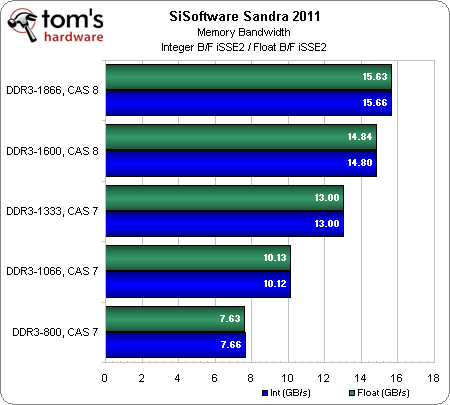
It’s possible to basically double bandwidth from 800 MT/s to 1866 MT/s, and you can see the returns starting to fall off as you hit higher signaling speed and give up timing for higher clocks. Good to know, though. Now let’s look at application performance and see how it corresponds.
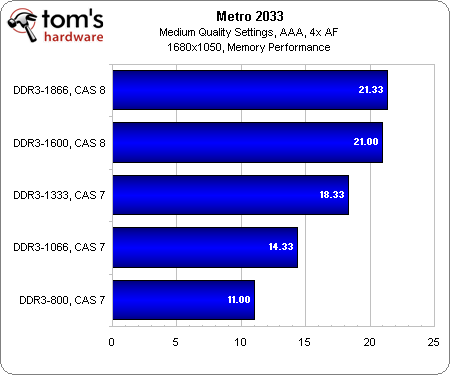
In Metro 2033, the move from DDR3-800 to DDR3-1600 nearly doubles performance, scaling almost perfectly with the bandwidth improvement measured in Sandra 2011. That’s a heavily graphics-bound benchmark, and it’s only at DDR3-1866 where the returns are no longer worth spending more on faster memory.
Get Tom's Hardware's best news and in-depth reviews, straight to your inbox.
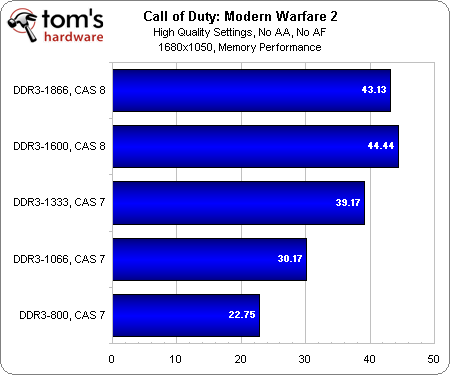
Call of Duty is known to scale well based on platform capabilities, not taxing graphics cards much at all. But again we see a doubling of performance when you downshift from DDR3-800 to DDR3-1600. There’s clearly a bump in the scaling story when we’re forced to use CAS 8 timings, but it really gets bad at DDR3-1866 when keeping the system stable requires relaxing tRCD to 9 and performance slips back the other way. If we could get our hands on some good DDR3-1600 CAS 7, that’d be ideal.
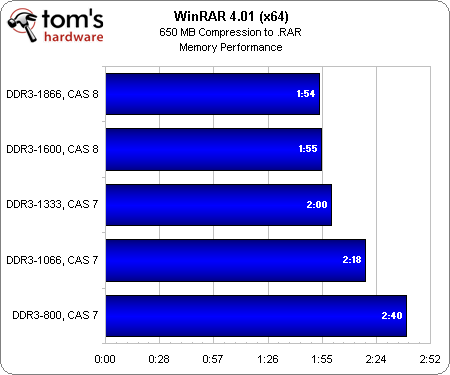
AMD’s processor architecture is less constrained by memory performance than the graphics engine. However, you still see significant gains moving from DDR3-800 to DDR3-1333. Beyond that, it’s really not worth paying extra for higher-end memory.
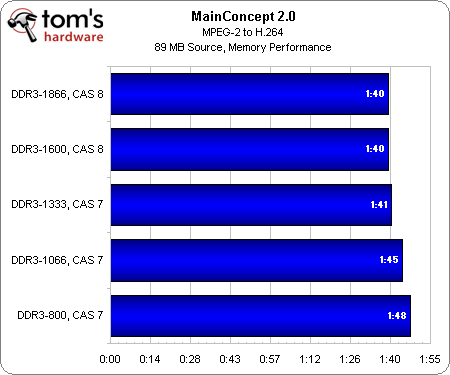
A transcoding job sees even less gain from fast memory than a file compression workload. You’ll see marginal speed-ups from DDR3-800 to DDR3-1333, but the amount of time you shave from an app like MainConcept is minimal.
Buy Fast/Low-Latency Memory
Despite marginal gains in application performance, the bottom line here is simple: if you want to get the best horsepower out of a Llano-based APU, that graphics engine needs to breathe. Memory able to support a high data rate at low latencies is absolutely imperative for the best possible frame rates in games.
Don’t sweat DDR3-1866 if it means CAS 8 or 9 timings. Aggressively-tuned DDR3-1600 looks to be the sweet spot. We had luck getting our Kingston HyperX DDR3-2133 kit running at DDR3-1600 CAS 7 on a couple of boards, but not the ASRock board we eventually used for testing. Even at CAS 8, though, performance was superb.
Current page: Making Memory Performance Matter Again
Prev Page Storage Performance Next Page A Word On Overclocking Llano-
SteelCity1981 So then what's the point of getting the Turbo Core versions when they are going to be Turbo Clocked slower then the none Turbo Clocked versions...Reply -
cangelini SteelCity1981So then what's the point of getting the Turbo Core versions when they are going to be Turbo Clocked slower then the none Turbo Clocked versions...Reply
They don't want you to see better performance from a cheaper APU in single-threaded apps by pushing Turbo Core further ;-) -
Known2Bone i really wanted see some amazing gains in the content creation department what with all that gpu power on chip... oh well games are fun too!Reply -
ivan_chess I think this would be good for a young kid's PC. It would be enough to run educational software and a web browser. When he grows up to be a gamer it would be time to replace the whole machine anyway.Reply -
DjEaZy ... it's may be not the greatest APU for desktop... but it will be a powerful thingy in a laptop... the review was nice... but in the gaming department... would be nice to see a standard 15,x'' laptop resolution tests @ 1366x768... or something like that...Reply -
Mathos Actually if you want good DDR3 1600 with aggressive timings, the Ripjaws X series memory that I have does DDR3 1600 at 7-8-7-24 at 1.5v, not all that expensive when it comes down to it either.Reply -
Stardude82 This makes little sense. An Athlon II X3 445 ($75) and a HD 5570 ($60, on a good day you can get a 5670 for the same price) would provide better performance for the same price ($135) and not have to worry about the RAM you use.Reply
So is AM3+ going to be retired in favor of FM1 in the near future? Why are there chipset at all? Why isn't everything SOC by now?
Otherwise this is a very good CPU. If AMD has used 1 MB level 2 caches in their quads when they came out with the Deneb Propus die, they would be much more competitive. -
crisan_tiberiu stardude82This makes little sense. An Athlon II X3 445 ($75) and a HD 5570 ($60, on a good day you can get a 5670 for the same price) would provide better performance for the same price ($135) and not have to worry about the RAM you use. what about power consumption?Reply
